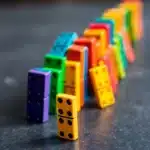Why Inconsistency Ruins Plans
(And How to Finally Stay Consistent)

We’ve all been there. You’ve got a killer plan, something between Leonardo da Vinci brilliance and “I’ll get my life together tomorrow” vibes. You start strong, maybe even crush the first few days. Then life happens. Netflix drops a new series. You forget once… then twice. And boom, your plan is toast.
The truth is, inconsistency ruins plans. It sneaks in quietly, steals your momentum, and leaves you wondering why nothing ever seems to stick. But don’t worry, you’re not doomed. In fact, once you understand why inconsistency wrecks your progress, you’ll see exactly how to stop it.
So grab a snack (burritos preferred), and let’s break down 10 hilarious, relatable, and super-practical reasons inconsistency ruins plans, and how to fix it.
1. Momentum Is Like a Rolling Burrito, Keep It Warm
Momentum is magical. When you show up daily, things click. Stop for too long, and it’s like letting your burrito get cold, soggy, sad, and not worth biting into.
Example: You’re on a three-day gym streak, feeling like Hercules. Skip “just one day”… and suddenly it’s been three weeks and your workout shoes are a dust exhibit.

Action Step: Protect momentum with tiny wins. Too tired to work out? Stretch for two minutes. Don’t want to write a blog post? Jot down one sentence. Keep the burrito warm.
2. The “Trust Me” Factor: People and Algorithms Notice

Consistency builds trust, with others and with yourself. Whether it’s social media algorithms or your best friend, vanishing breaks reliability.
Example: Your favorite YouTuber disappears for six months. Do you stick around? Nah. Same thing happens when you ghost your own goals.
Action Step: Define your baseline. Maybe it’s one social post a week or calling a friend every Friday. Keep it doable. Trust is built one repeat at a time.
3. Brain Jammin’: Your Focus Gets All Scrambled
Starting and stopping fries your brain. Each time you restart, you waste energy just remembering what you were doing.
Example: Trying to write a book in spurts? You forget your own plot. Studying inconsistently? You re-read notes instead of learning.

Action Step: Use the “bookmark trick.” End every session with a quick note: “Next step = X.” Future you will thank you.
4. Compound Effect, Hello, Missed Gains

Consistency works like compound interest. Small actions pile up into massive results. Inconsistency? It breaks the chain.
Example: Saving $5 a day adds up to $1,825 a year. Skip randomly, and suddenly it’s half that.
Action Step: Choose one tiny daily habit. Two pushups, two pages, one glass of water. Small stacks add up fast.
5. Identity Crisis: Who Are You Anyway?
Inconsistency messes with your self-story. You want to be “a writer,” but if you only write once every three months… your brain calls BS.
Example: Sarah paints daily for a month and calls herself an artist. She stops for three months and suddenly doubts her creativity.

Action Step: Anchor identity to small habits. “I read a page daily” is stronger than “I want to be a reader.” Identity grows from repetition.
6. Confidence Tank = Empty

Skipping builds self-doubt. Every time you break a promise to yourself, your brain logs it as “see, we can’t be trusted.”
Example: You pick up the guitar after months off and suck again. Confidence gone. Motivation follows.
Action Step: Start a “confidence jar.” Each day you show up, add a note. Watching proof stack up rebuilds self-trust.
7. Plans Need Attention, Like Pets, Not Just Plans
Plans aren’t “set and forget.” They’re like pets, ignore them, and they starve.
Example: Week one of meal prep: gold star. Week two: no groceries. Week three: back to takeout. Plan = dead.
Action Step: Create a “plan check-in” ritual. Every Sunday, ask: Does it need tweaking? Is it working? Feed your plan.

8. The Domino Effect: One Slip, Many Flops

One skipped day isn’t deadly, it’s the cascade that kills. Miss one, shrug. Miss two, the week’s gone.
Example: Skipping Monday’s workout snowballs into a two-week slump.
Action Step: Use the “never miss twice” rule. Miss once? Fine. Miss twice? Nope. Stop the dominoes from falling.
9. Chaos Energy = More Stress
Inconsistency = clutter. Your brain drowns in half-done projects, nagging reminders, and guilt.
Example: Yarn in one corner, guitar in another, unread books stacked high. Instead of joy, it feels like chaos.

Action Step: Simplify. Choose one or two priorities. Close small loops daily with a two-minute tidy. Peace restored.
10. Fake Start Syndrome

The worst trap? Restarting endlessly. Each “new beginning” feels heavier until you stop believing in them.
Example: New Year’s resolutions that fizzle by February. Each restart chips at belief.
How to Fix It: Keep Your Glow, Not the Flame Flicker
Alright, enough brokenness, time for the fix. Here's your friendly, semi-fun "consistency rescue plan":
A. Mini Moves, Baby Steps
Don’t dive into full-on every-day hustles. Start micro. Write one line. Do one push-up. That “one” is powerful, it sparks momentum.
B. Anchor It to Something You Already Do
Want to journal? Do it right after brushing your teeth. Want to stretch? Do it before your morning coffee. If it's tied to an existing habit, it's easier to make it stick.
C. Keep Track (Without Judging Yourself)
Simple tools: tick-boxes, habit trackers on your phone, or doodles in your journal. Seeing the streak builds motivation to keep it going.
D. Make Your Plan Feel Like You
Make it fun, add emojis if you're journaling. Make it funny, "do plank or riot." Make it you. When the vibe matches your vibe, you’re more likely to show up.
E. Accountability, but Chill
Tell a friend, post to a private group, or add it to your shared calendar. Peer-pressure can be gentle and helpful.
F. Reward Yourself
Small wins deserve celebration. Hit a 7-day streak? Treat yourself to a luxury coffee, a silly dance, or five-minute Insta binge.
G. Expect Slip-Ups
Life happens. The goal isn’t perfection, it’s progress. Slip one day? Acknowledge it. Bounce back tomorrow, just like hitting “restart” on your burrito, not the whole microwave.
H. Reflect Weekly, Not Daily
Write a tiny “how’s it going?” Sunday check-in. Did you show up? Was it hard? Celebrate, tweak, repeat.
Wrapping It Up, But Like, With Sass and Heart
Look, none of us are consistency wizards. But we can be consistency realists. That means small steps, fun habit linking, gentle tracking, and celebrating wins (even the goofy mini ones).
Remember: “inconsistency ruins plans” isn’t just a phrase, it’s a siren song telling you to shift. Stay consistent, and you'll slowly (and sneakily) build momentum. You'll trust yourself. Goals become fun. Plans don’t feel like scramblathons, they feel like natural rides.
To follow the right path watch these FIVE FREE VIDEOS
